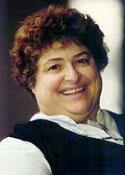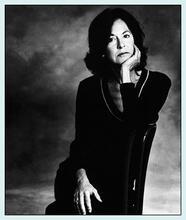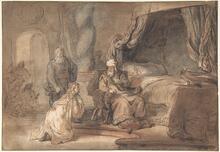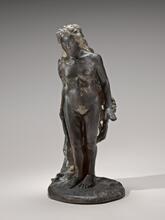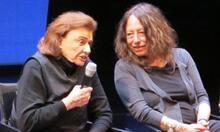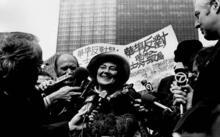Daughter Zion (Bat Tzion)
The metaphor of Jerusalem as “Daughter Zion” (bat tzion in Hebrew) has profound implications for the reading of gender and theology in the Hebrew Bible. Initially, Daughter Zion is positively likened to a daughter under the special regard of the father figure, God (2 Kings 19:21, Isaiah 37:22). With the Babylonian siege and destruction of Jerusalem (586 BCE), the personification turns dark; she has brought this devastation upon herself by playing the harlot (as in Isaiah 1:8, 21). In Lamentations, she is given voice and protests that she is punished far in excess of her sins. In the prophecies of consolation, dating to the return to Zion (6th-5th century CE), Daughter Zion is forsaken no more and returns “home”—a joyful mother of children (as in Isaiah 54:1).
The Implications of the Metaphor
Jerusalem, the center of cultic worship and capital of the Judean people, is personified throughout poetic and prophetic biblical passages as a woman—“Daughter Zion (bat tzion)” or “Fair Zion” (as in 2 Kings 19:21, Psalm 9:15, Isaiah 1:8, and so forth). As a conceptual metaphor, the term yields multiple meanings for God’s relationship to the people, the land, and the Temple at its sacred center. The term “Daughter Zion” (like “Daughter Babylon/Chaldea,” in Psalms 137:8, Isaiah 47:1, 5, Jeremiah 50:42, 51:33, and Zechariah 2:7; “Daughter Edom,” in Lamentations 4:21, 22; or “Daughter Egypt” in Jeremiah 46:11, 19, and 24) is not to be understood in the sense of daughter of Zion, but rather in the sense of Zion as daughter (bat). The name “Bat Tzion” then serves as a term of endearment. The identification of cities or lands in the Bible as female may derive from the association of city-states in the ancient world with a patron goddess, as Athena, daughter of Zeus, is associated with the ancient Greek city of Athens. Studies in Ancient Near Eastern literature point to a city-lament genre, in which the goddess decries the destruction of her city and its people. Whereas the patron goddess bemoans the fallen city in Lipur or Ancient Sumer, in the Book of Lamentations it is Daughter Zion, the city itself personified, who voices the dirge and pleads the cause of her devastated and exiled people (Lamentations 1:9b, 11b-15a, 16, 18-22; 2:11-12).
The role of daughter also has implications for how the metaphor plays itself out across the biblical corpus. Under the aegis of the father, the unmarried daughter is the most precious figure and, therefore, potentially the most vulnerable in the household. In the patriarchal world of the Bible, she remains protected within her father’s household until she moves to her husband’s home. She is an extension of her father’s honor; her bride-price is determined by her status as a virgin and the father bears the consequences if she is raped or debased (Exodus 22:15-16, Deuteronomy 22:13-29). Likewise, God as “father” is ultimately responsible for Daughter Zion’s honor, and God is later implicated in her devastation in Lamentations and the prophecies of lament and consolation.
Origins and Evolution of the Metaphor
Initially, Jerusalem, the city of David [tzion], is positively likened to a daughter, protected under God’s special regard, suggestive of the sacred relationship between the people and the divine presence in the Temple and Jerusalem. Jerusalem is first introduced as Daughter Zion in Isaiah’s prophecy against Sennacherib (2 Kings 19:21, Isaiah 37:22), upon the Assyrian general’s invasion of Judea (circa 701 BCE). Daughter Zion defies the royal invader who would penetrate her walls, pillage her treasures, and slay or carry away her children as slaves. Under King Hezekiah’s reign (and Isaiah’s prophetic regard), Jerusalem successfully spurns the foreign conquest, for God, the father, protects her by sending an Angel of the Lord to strike the Assyrian camp arrayed outside her walls, whereupon the enemy withdraws (2 Kings 19:36, Isaiah 37:36, and 2 Chronicles 32:21). In Psalms, the personification of the city and its inhabitants as a “princess,” who is protected by the King, sequestered within the walls of the city or palace, modest and highly honored, virtuous and coveted, highlights the sense of Zion’s invincibility under divine protection (Psalms 9:15, 45:9-16).
But the metaphor turns darkly upon itself in the poetry and prophecy of lament, when she (Jerusalem) is devastated, even ravaged (Isaiah 1:8, Lamentations 1:6, 2:1, 4, 8, 10, 13 and 4:22). The mid-8th century BCE prophet Amos first draws upon the motif of the fallen maiden, with regard to “virgin Israel” (betulat Yisrael), in his lament for the Northern Kingdom: “forsaken on her land, with none to raise her up” (Amos 5:1-2; cf. Jeremiah 31:2, 4). Likewise in Isaiah’s prophecy of doom against Jerusalem, Daughter Zion will be abandoned like a “booth [sukkah]” in the fields (Isaiah 1:8, cf. Lamentations 2:6), a temporary dwelling exposed to wind and rain, her stone walls crumbling, her inner being exposed, unguarded and under siege; the “faithful city has become a whore” (Isaiah 1:21). Her vulnerability and violation contrasts with her proud, even haughty sense of her own invincibility, which she flaunted when miraculously saved from the Assyrian invasion. In Isaiah’s rebuke, the prophet turns the image of a princess who scorns and tosses her head into a pauper, reduced to rags, exposed to the elements.
In the Book of Lamentations, multiple voices decry the destruction of the Temple and the banishment of the Judeans into captivity in 586 BCE. Initially, we see Jerusalem, once “thronged with people,” sitting alone as a widow; “she that was great among the nations, princess among provinces, has become a thrall/vassal!” (1:1). Later, she is explicitly identified as Bat Tzion—yet “all her splendor has gone” (1:6). As the lament unfolds, the omniscient narrator who bears witness to her degradation impugns her; she has brought this upon herself through her own sins (8-11a). Similarly, the prophets condemn Israel, the collective people personified as a woman, who betrayed her husband (God) in committing “harlotry” by following after false gods (Hosea 1-3, Ezekiel 16, 23, Jeremiah 3:1-3). Consequently, she is stripped, left naked and bare, exposed for her whoredom; those who defiled her come to despise her (Ezekiel 16:37-39, 23:29, Lamentations 1:8, 2:15-16).
When Daughter Zion Talks Back
In Lamentations, however, Daughter Zion is not wholly abandoned to her shame and abject status. The tone of condemnation shifts after she is given her own voice. Speaking in the first person, she begs the outsider to bear testimony, to witness her suffering and not to scorn her (Lamentations 1:11b-13). When she “talks back to the prophets” (Mandolfo 82), chafing against the misogynist tropes in Hosea, Jeremiah, and Ezekiel that blame the daughter, the reader and God’s compassion are stirred. Over the course of chapter 2, in the voice of the narrator, we see an intensification of sympathy with her, variously referred to as Daughter Zion [Bat Tzion] (Lamentations 1:6; 2:1, 2, 4, 5, 8, 10, 13, 15, and 18; 4:21 and 22), Daughter Judah [Bat Yehudah] (1:15; 2:2, 5 and 13), and Daughter, My People [bat ‘ami] (2:11; 3:48; 4:3, 6 and 10.). The acrostic poem (following the Hebrew alphabet) includes a litany of destruction (at God’s hand)—of the city citadel, strongholds, walls, and ramparts—and a gruesome account of starvation: children and babies collapsed in the city square, dying in their mother’s arms (2:11-12). The narrator finally calls out for a witness and a source of consolation (2:13). Though she remains publicly scorned—the passersby clap their hands, “they whistle at [her] and wag their heads” (2: 15), decrying the loss of her beauty—the narrator finally acknowledges that God has more than fulfilled His punitive decree: “Your punishment is completed, Daughter Zion [Bat Tzion]. He will not keep you exiled any longer…” (4:22).
Daughter Zion’s Redemption
In later prophecies of consolation and return, the daughter (Bat Tzion or Bat Yerushalayim) is promised full restoration, a return to her former joy. No longer would the defiled and uncircumcised enter her (Isaiah 52:1), no longer would she be held as a “captive daughter” (v. 2); instead, God would deliver her (Isaiah 54:1, 6-8; 62:11) and come to dwell in her midst (Isaiah 52:8, Micah 4:2, 7-8; and Zechariah 2:10, as in the original Tabernacle Exodus 25:8). She is then called upon to sing aloud and rejoice (Zephaniah 3:14, Zechariah 2:10 and 9:9). These prophecies anticipate (or are coterminous) with the period of the “return to Zion” [Shivat Tzion], after the conquest of the neo-Babylonian Empire and Persian King Cyrus’ decree that the Jews could return to their homeland and rebuild the Temple (539 BCE).
Baumann, Gerlinde. Love and Violence: Marriage as Metaphor for the Relationship between YHWH and Israel in the Prophetic Books. Collegeville, MN: Liturgical Press, 2003.
Boda, Mark J. et. al., eds.. Daughter Zion: Her Portrait, Her Response. Atlanta: Society of Biblical Literature, 2012.
Bohmbach, Karla. “Daughter.” In Women in Scripture, edited by Carol Meyers, 517-519. Boston and New York: Houghton-Mifflin, 2000.
Berlin, Adele. Lamentations, A Commentary. Louisville and London: Westminster John Knox Press, 2002.
Day, Peggy. “The personification of Cities as Female in the Hebrew Bible: The Thesis of Aloysius Fitzgerald, F.S.C.” In Reading from this place. II. Social Location and Biblical Interpretation in Global Perspective, edited by Fernando F. Segovia and Mary Ann Tolbert, 283-302. Minneapolis: Augsburg Fortress, 1995.
Kaiser, Barbara Bakke. “Poet as ‘Female Impersonator’: The Image of Daughter Zion in Biblical Poems of Suffering.” Journal of Religion 67:2 (1987): 164-182.
Maier, Christl M. Daughter Zion, Mother Zion. Minneapolis: Fortress Press 2008.
Mandolfo, Karla. Daughter Zion talks back to the Prophets: A Dialogic Theology of The Book of Lamentations. Atlanta: Society of Biblical Literature, 2007.


